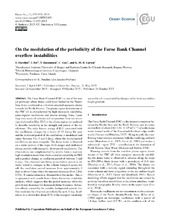| dc.contributor.author | Darelius, Elin Maria K. | |
| dc.contributor.author | Fer, Ilker | |
| dc.contributor.author | Rasmussen, Till | |
| dc.contributor.author | Guo, Chuncheng | |
| dc.contributor.author | Larsen, Karin Margretha Húsgarð | |
| dc.date.accessioned | 2016-11-04T13:24:49Z | |
| dc.date.available | 2016-11-04T13:24:49Z | |
| dc.date.issued | 2015-10-26 | |
| dc.Published | Ocean Science 2015, 11(5):855-871 | eng |
| dc.identifier.issn | 1812-0792 | en_US |
| dc.identifier.uri | https://hdl.handle.net/1956/13059 | |
| dc.description.abstract | The Faroe Bank Channel (FBC) is one of the ma- jor pathways where dense, cold water formed in the Nordic Seas flows southward as a bottom-attached energetic plume towards the North Atlantic. The plume region downstream of the FBC sill is characterized by high mesoscale variability, quasi-regular oscillations and intense mixing. Here, 1 year long time series of velocity and temperature from ten moor- ings deployed in May 2012 in the plume region are analysed to describe variability in the strength and period of the os- cillations. The eddy kinetic energy (EKE) associated with the oscillations changes by a factor of 10 during the year and the dominant period of the oscillations is modulated and varies between 3 to 4 and 6 days, where the shorter-period oscillations are more energetic. The dense water is observed on a wider portion of the slope (both deeper and shallower) during periods with energetic, short-period oscillations. The observations are complemented by results from a regional, high-resolution model that shows a similar variability in EKE and a gradual change in oscillation period of between 3 and 4 days. The observed variability in oscillation period is di- rectly linked to changes in the volume transport across the sill: the oscillation period increases from approximately 3 days to about 6 days when the transport decreases from 2.4 to 1.9 Sv. A similar relation is obtained from the model. This is in agreement with results from a linear baroclinic instability analysis, which suggests that the period increases while the growth rate decreases for decreased plume thickness. Advec- tive effects, caused by the variable background current, fur- ther modulate the observed periodicity by up to 1 day. In ad- dition, it is shown that about 50 % of the transport variability across the sill is explained by changes in the local sea surface height gradient. | en_US |
| dc.language.iso | eng | eng |
| dc.publisher | Copernicus Publications | en_US |
| dc.rights | Attribution CC BY | eng |
| dc.rights.uri | http://creativecommons.org/licenses/by/3.0/ | eng |
| dc.title | On the modulation of the periodicity of the Faroe Bank Channel overflow instabilities | en_US |
| dc.type | Peer reviewed | |
| dc.type | Journal article | |
| dc.date.updated | 2016-10-24T08:15:41Z | |
| dc.description.version | publishedVersion | en_US |
| dc.rights.holder | Copyright Author(s) 2015 | en_US |
| dc.identifier.doi | https://doi.org/10.5194/os-11-855-2015 | |
| dc.identifier.cristin | 1298645 | |
| dc.relation.project | Norges forskningsråd: 204867 | |

